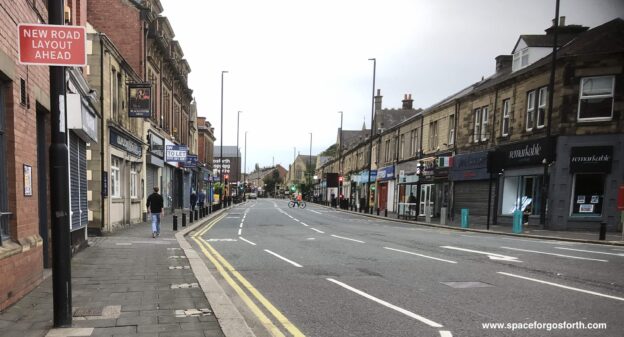
Gosforth High Street is our most important local destination in Gosforth. We want the shops to be successful and, as we set out in our previous blog, an important part of that is enabling people to get to and move around Gosforth High Street safely.
The trial design implemented by Newcastle City Council doesn’t even adhere to the most basic safety principle, namely to separate people walking and cycling from heavy, fast moving vehicles. Instead they expect people cycling along or across the High Street to share a lane with buses, or separated only by paint from heavy traffic.
If you want a better, safer, more ambitious, plan for Gosforth High Street, you need to respond to the Council’s consultation ASAP. Please also be clear you don’t want a return to the pre-Covid layout as that was no better!
| Have your say on Gosforth High Street bus priority measures consultation ends 21 September 2023 |
In this blog we look at safety concerns with the current layout and reveal the alternative safer option rejected by the Council, which we have obtained via a Freedom of Information request.
Issue 1. Forcing people and heavy vehicles to share road-space is not designing to the “highest safety standard for all road users”
In November 2022, Newcastle City Councillors voted for a new design for Gosforth High Street that met the “highest safety standard for all road users”.
If people were happy to cycle in heavy traffic we might see more people cycling on Gosforth High Street. Department for Transport surveys have consistently shown a majority of people (>60%) think it is too dangerous to cycle on the roads due to motor traffic.
In the central section of the High Street there is now a north-bound bus lane and a south-bound advisory lane for cycling.
People cycling are able to use bus lanes but they aren’t designed for that purpose. Department for Transport guidance states that bus lanes “do not provide an environment attractive to a wide range of people and should therefore not be regarded as inclusive. Some bus lanes also allow taxis and motorcycles to use them [as is the case on Gosforth High Street], which can signifcantly increase traffc fows, thereby acting as a deterrent to cycling while also increasing risk of confict.” Conflict, in this scenario, could include collisions and / or injuries, most likely to the person or people cycling.
The same guidance advises that advisory lanes are “not be suitable for all people and will excluded some potential users and/or have safety concerns” given the volume of traffic, and that “Advisory lanes are not recommended where they are likely to be blocked by parked vehicles.“
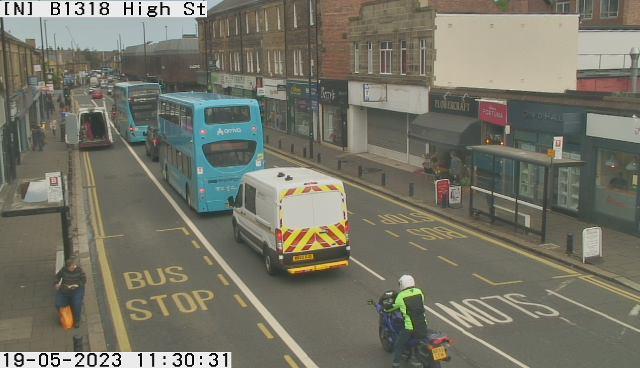
Van illegally parked blocking the Gosforth High Street bus lane
The presence of parked vehicles almost doubles the risk to people cycling.
Designing only for confident and experienced cyclists, as the Council have done on Gosforth High Street, excludes most people who could cycle, especially older and younger people who would be most at risk in a collision.
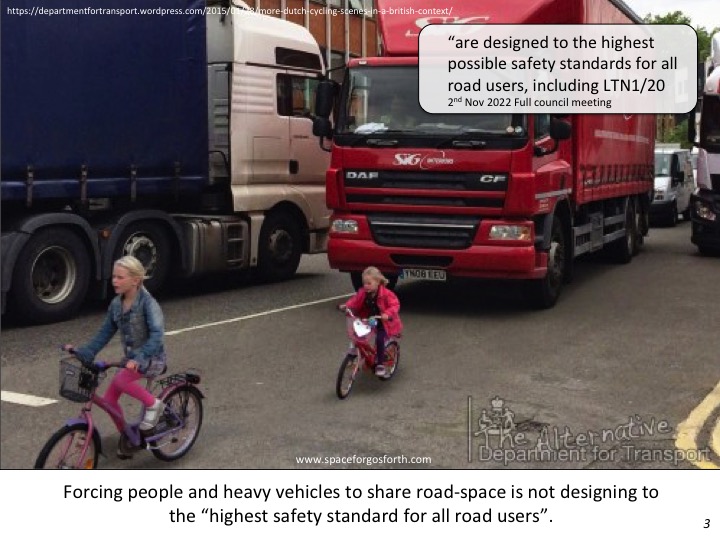
Photoshopped picture from the Department for Alternative Transport Blog.
The Council’s proposal implies that people including children, families and older people who wish to cycle to or between shops on the main section of Gosforth High Street should either:
- cycle in a bus lane or painted cycle lane, without any physical separation or protection from heavy motor traffic; or
- be prevented from travelling in the way that they wish, counter to the Council’s commitment to inclusive design to be safe for all users as well as its policy of encouraging sustainable travel.
Providing an alternative route on Moor Road is useful for people travelling from north of Gosforth to the city centre. However, this is a diversion away from the High Street, which for many people will be their destination, and neither resolves safety issues on the High Street nor helps travel within or across the High Street.
Issue 2. Close Passes – by design
South of The County, existing painted cycle lanes have been retained. DfT guidelines stated that painted lanes on busy roads “exclude some potential users and/or have safety concerns.” Adding an extra traffic lane makes these even less usable.
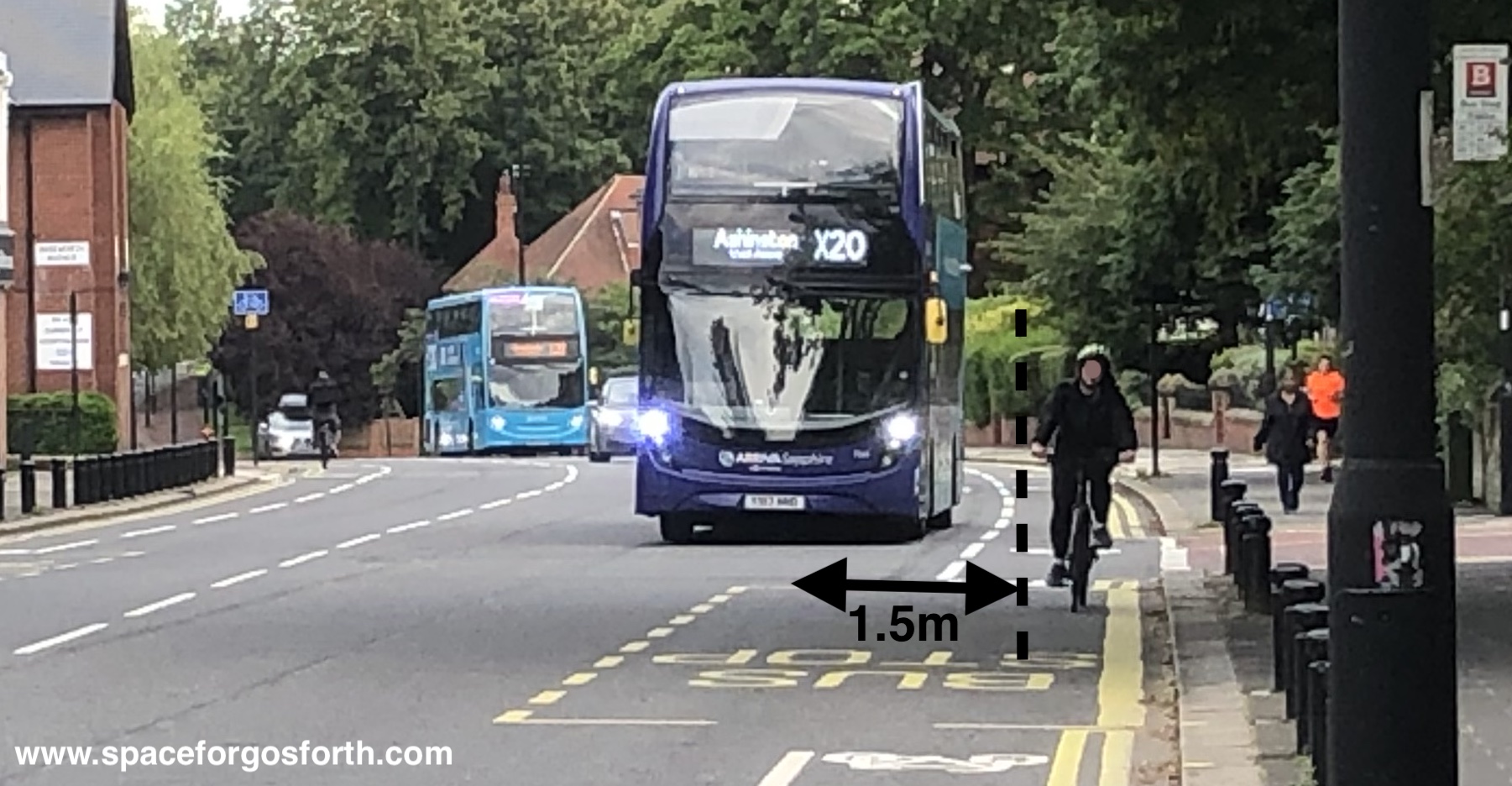
Drivers should leave at least 1.5m when overtaking cyclists
Specifically, the new Highway Code requires drivers to leave at least 1.5 metres when overtaking cyclists. This was just about possible with previous lane widths south of Elmfield Road, but is now much harder with an extra vehicle lane squeezed in – as the diagram below shows.
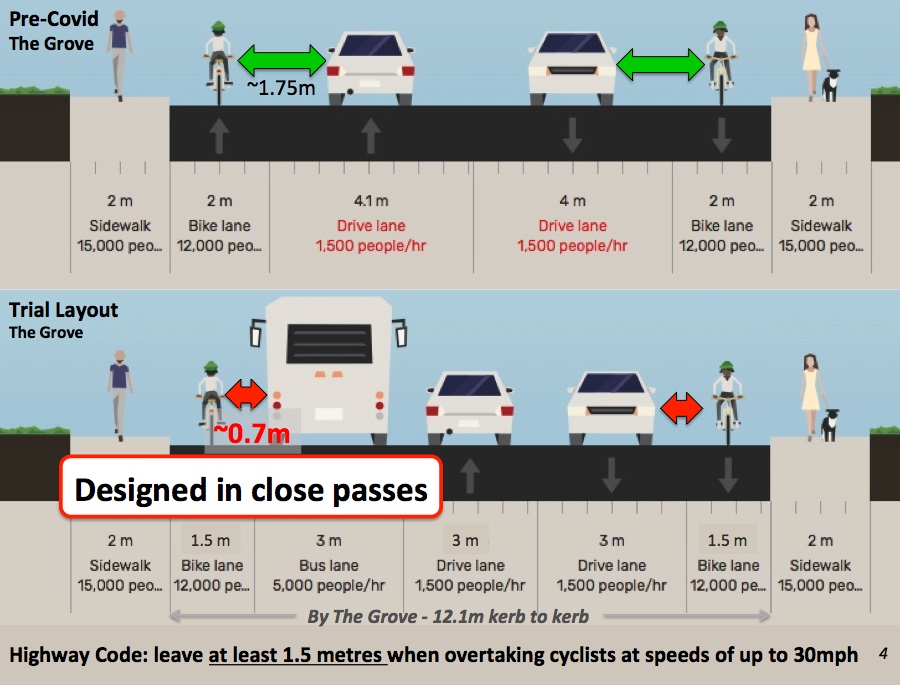
Streetmix.net mock up of High Street lane widths before and after,. Cycle lanes have been reduced to 1.5m
Drivers, including bus and taxi drivers, can be prosecuted for close passes within 1.5m. Northumbria Police operate a ‘dash cam submission’ website where people can submit video evidence. Even so, close passes are deeply uncomfortable and potentially dangerous for the person who has been ‘close passed’, and will most likely put off even some experienced cyclists from cycling along Gosforth High Street.
This safety risk could be partially mitigated by having cycle lane ‘defenders’ to physically separate people and vehicle traffic, but the current trial doesn’t include this and lanes would still be non-compliant with standards due to being too narrow.
Issue 3. High Street Crossings
Prior to the wands being installed residents complained regularly that vehicles either ignored or did not see the pedestrian traffic lights by the shopping centre. The picture below from Google StreetView (pre-Covid) shows why this happens.
This can be partially mitigated by moving the stop line back and away from the crossing, though won’t be fully resolved while there are multiple north-bound vehicle lanes.
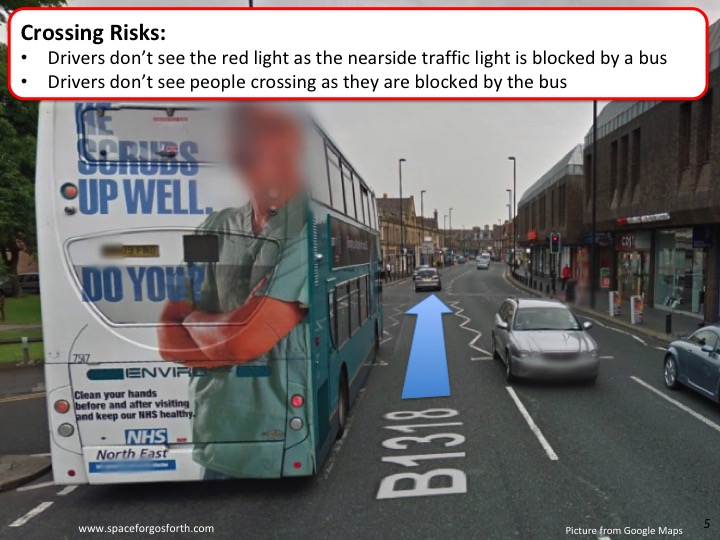
To make it easier for people to move around Gosforth High Street, pedestrian crossings also need to be set to change quickly once the button has been pressed and allow plenty of time for people to cross.
Issue 4. Severance
The November 2022 Council motion stated the new design should “enable low-carbon options to enable people to travel to, along and across the High Street”. This is to prevent ‘community severance‘, the widely-studied effect where a busy road or other transport infrastructure splits adjacent built-up areas making it harder to travel between the two.
In the trial layout, anyone cycling from east to west or vice versa across Gosforth High Street has to share a lane with heavy traffic as most crossings are offset, and most people are not willing to cycle using offset crossings that require mixing with heavy traffic. Without safe cycle-crossings on Gosforth High Street east-west cycling journeys become much harder as there are only a few places where people can safely cross The Great North Road. If cycling is made harder then people are less likely to travel and/or may drive instead.
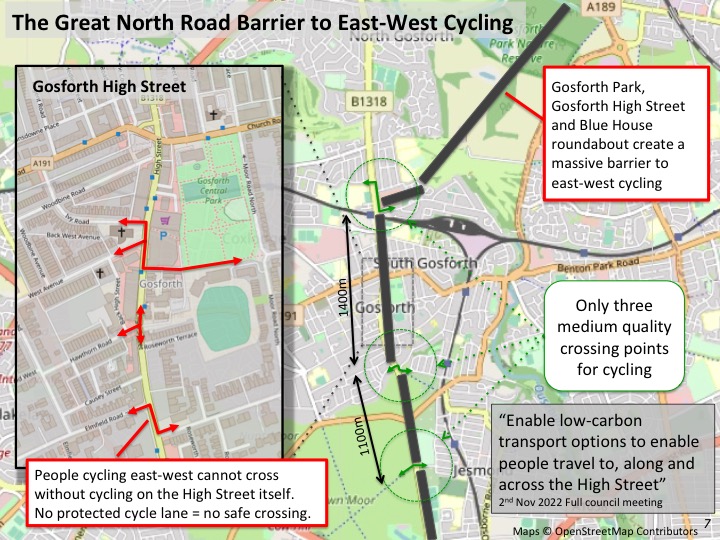
Failure to Design to UK Standards
The November 2022 Council motion called for Gosforth High Street to be designed to be safe for all users and in accordance with LTN1/20 standards. LTN1/20 is the safety standard for cycling.
A design in accordance with LTN1/20 would allow people to cycle to, through and across the High Street, stop outside shops and ride safely between shops e.g. if picking up a bottle of wine at Carruthers and Kent, then getting a takeaway from Gosforth Chippy or the New New Bengal.
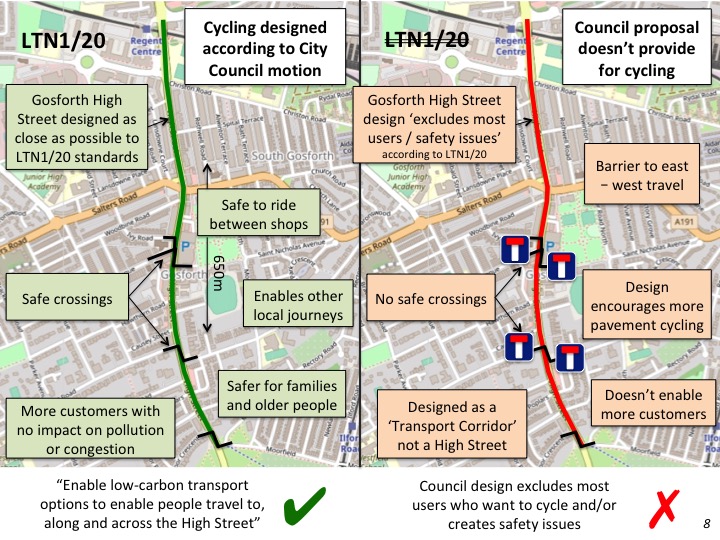
This would enable more people to travel to shop on Gosforth High Street without adding to existing high levels of pollution and congestion, and would make Gosforth High Street itself a more attractive destination by creating a gap between the pavement and heavy traffic. This would also allow some of the black bollards to be removed enabling the full width of the pavements to be used.
We sent a briefing containing all these points to the Newcastle City Council Cabinet (who in November 2022 all voted for the highest possible safety standards!) on 19 February 2023, a month or so prior to the new layout being implemented..
The Alternative Plan
Newcastle City Council did produce an alternative plan that they didn’t use. This included the extended bus lane up to Hawthorn Road, but with protected cycle lanes through the main section of the High Street.
This wouldn’t have resolved all the issues listed above but would be a substantial improvement on what is there now, allowing both for reliable bus times and greater safety for all road users.
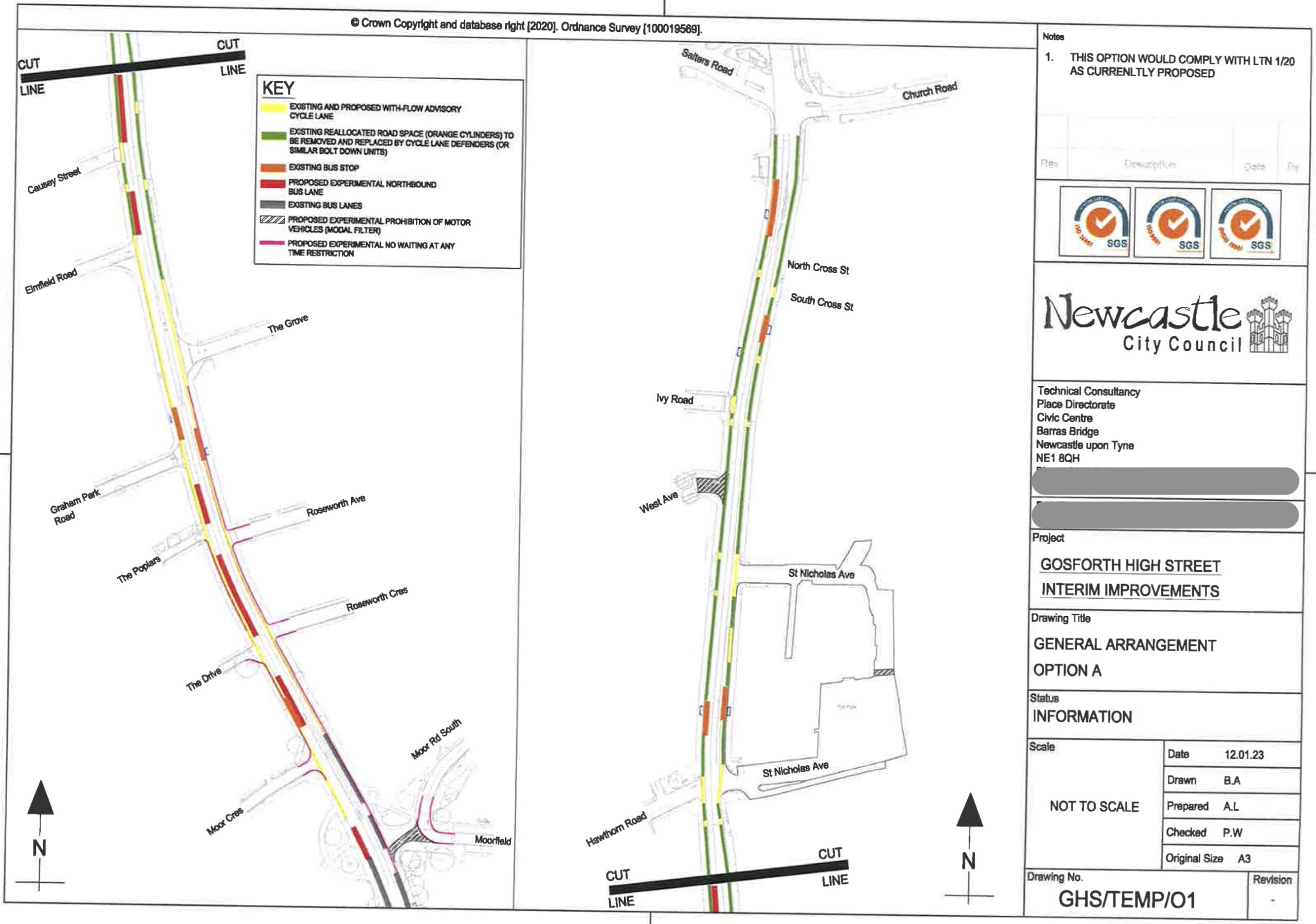
The consultation for the trial bus-priority measures runs until 21 September and you can share your thoughts on the Council’s CommonPlace website.
Commenting on a new funding for a cycle route on Elswick Road in May, the Council said “We want everyone in Newcastle to be able to choose and benefit from active travel. This leads to better physical and mental health; stronger, connected communities and a better, more sustainable environment for future generations.” We just want the same for Gosforth High Street.
Extract from “Gosforth High Street’s future” – motion approved unanimously by City Council November 2022
Council welcomes proposals to replace the bollards on Gosforth High Street with a permanent scheme developed collaboratively with people in the local area to make Gosforth High Street more people-friendly and improve facilities for active travel and public transport.
…
Council resolves to ask Cabinet to ensure proposals for Gosforth High Street:
- Support the development of Gosforth High Street as a thriving local destination with a diverse range of shops and services.
- Are designed to the highest possible safety standards for both pedestrians and all road users, including LTN1/20* which was recently adopted as the standard by Cabinet.
- Enable low-carbon transport options to enable people travel to, along and across the High Street, cut pollution and support the city’s ambition to achieve net zero by 2030.
- Enhance the green infrastructure on Gosforth High Street, in line with the Council’s commitments on biodiversity and maximising nature-based ways to reduce air pollution.
- Are delivered urgently to achieve these benefits as soon as possible, but not without meaningful engagement with local residents about the options and impacts of various schemes.

